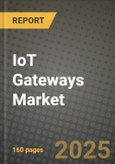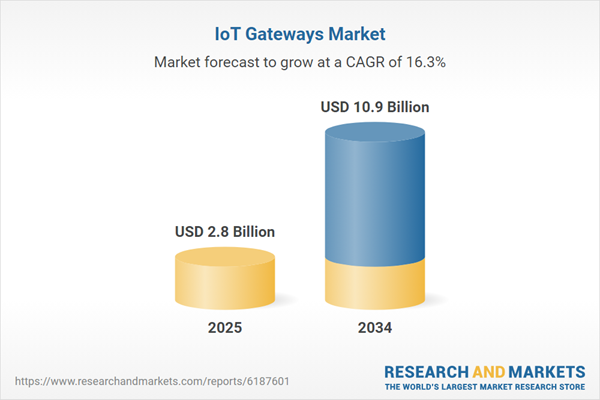The IoT Gateways Market focuses on devices that act as intermediaries between endpoint IoT devices and central computing systems, enabling seamless data transmission, protocol conversion, local processing, and security enforcement. IoT gateways are essential components in distributed IoT architectures, particularly where edge computing, interoperability, and real-time responsiveness are critical. These gateways support a wide range of wired and wireless communication protocols - such as Wi-Fi, Zigbee, Z-Wave, LoRa, Bluetooth, and cellular - allowing integration of heterogeneous devices into a unified IoT network. From industrial automation and smart cities to agriculture, logistics, and healthcare, IoT gateways enable actionable intelligence at the edge while reducing cloud load and improving latency. The growing scale and complexity of IoT deployments have cemented gateways as strategic enablers of connected ecosystems.
The IoT gateways market witnessed strong growth driven by the expansion of smart infrastructure, edge AI, and 5G rollouts. Companies like Cisco, Advantech, Dell Technologies, and NXP launched modular gateways with advanced processing capabilities, ruggedized designs, and seamless integration with edge-to-cloud platforms. Industries adopted gateways to support predictive maintenance, autonomous asset monitoring, and smart facility management. Public sector initiatives embraced gateways for smart lighting, traffic control, and environmental monitoring. 5G-enabled gateways became prominent in low-latency applications like autonomous vehicles and industrial robotics. The adoption of Linux-based and containerized gateways grew as organizations demanded customizable software stacks. Simultaneously, cybersecurity became a priority, with gateways supporting secure boot, encryption, and remote authentication protocols to guard against rising cyber threats.
The IoT gateways market will shift toward more intelligent, adaptive, and interoperable edge nodes. Gateways will increasingly include built-in AI and ML engines, enabling on-device inferencing, anomaly detection, and self-healing capabilities. The convergence of operational technology (OT) and IT will drive demand for gateways that bridge both environments securely and efficiently. With rising interest in private 5G and Wi-Fi 7, gateway designs will evolve to support advanced wireless networking and dynamic network slicing. Integration with digital twin environments will allow gateways to model, predict, and simulate system behavior in real-time. Furthermore, low-code development frameworks and remote orchestration tools will make it easier to deploy, configure, and manage gateway fleets. As businesses prioritize localized intelligence and reliable edge computing, IoT gateways will continue to anchor connected transformation strategies across verticals.
Key Insights: IoT Gateways Market
- The analyst highlights the adoption of AI-powered gateways capable of running edge analytics, enabling organizations to detect anomalies, trigger alerts, and take automated action without relying on cloud connectivity.
- Multi-network gateways supporting Wi-Fi, 5G, LoRa, and satellite links are trending, providing continuous connectivity across different locations and network conditions, especially in mobile and remote deployments.
- According to the analyst, the demand for containerized gateway software is rising, with businesses using Docker and Kubernetes to deploy microservices and custom logic directly at the edge.
- Gateways that facilitate OT-IT convergence are gaining traction, especially in manufacturing and energy sectors where seamless data exchange between industrial equipment and enterprise systems is critical.
- Sustainability-aware gateway designs with energy-efficient processing and remote diagnostics are emerging as organizations seek to reduce power consumption and carbon footprints in edge deployments.
- The analyst identifies the increasing complexity of IoT environments as a key driver, with businesses needing gateways to manage protocol translation, data aggregation, and device lifecycle management at scale.
- The rise of smart cities, smart buildings, and Industry 4.0 initiatives is fueling demand for gateways that provide low-latency data processing and enable decentralized automation, says the analyst.
- The analyst notes that cloud cost optimization and the need to reduce data transmission volume are encouraging enterprises to deploy edge-processing gateways that pre-filter and compress data before sending it upstream.
- Wider adoption of private cellular networks and industrial wireless standards is boosting demand for advanced IoT gateways capable of seamless network integration and dynamic routing across environments.
- The analyst highlights interoperability limitations among proprietary devices and communication protocols, which often require extensive customization and increase deployment complexity for gateway solutions.
- According to the analyst, maintaining consistent security across distributed gateway fleets - especially in unmonitored or outdoor locations - remains a challenge due to firmware update delays and access control vulnerabilities.
IoT Gateways Market Segmentation
By Component
- Processor
- Sensor
- Memory and Storage Device
- Other Components
By Connectivity
- Bluetooth
- Wi-Fi
- ZigBee
- Ethernet
- Cellular
- Other Connectitvities
By End-User
- Automotive and Transportation
- Healthcare
- Industrial
- Consumer Electronics
- Banking
- Financial Services and Insurance (BFSI)
- Oil and Gas
- Retail
- Aerospace and Defense
- Other End-Users
Key Companies Analysed
- Dell Inc.
- Huawei Technologies Co. Ltd.
- Hewlett Packard Enterprise Co.
- Cisco Systems Inc.
- Texas Instruments Incorporated
- STMicroelectronics N.V.
- TE Connectivity Ltd.
- Eurotech Inc.
- NXP Semiconductors
- Harman International Industries Inc.
- Microchip Technology Inc.
- Super Micro Computer Inc.
- Advantech Co. Ltd.
- Kontron S&T AG
- Pepperl+Fuchs Inc.
- Banner Engineering Corp.
- Samsara Networks Inc.
- ADLINK Technology Inc.
- Aaeon Technology Inc.
- Softing Industrial Automation GmbH
- Multi-Tech Systems Inc.
- Helium Systems Inc.
- Winmate Inc.
- Rigado LLC
- ClearBlade Inc.
IoT Gateways Market Analytics
The report employs rigorous tools, including Porter’s Five Forces, value chain mapping, and scenario-based modeling, to assess supply-demand dynamics. Cross-sector influences from parent, derived, and substitute markets are evaluated to identify risks and opportunities. Trade and pricing analytics provide an up-to-date view of international flows, including leading exporters, importers, and regional price trends.Macroeconomic indicators, policy frameworks such as carbon pricing and energy security strategies, and evolving consumer behavior are considered in forecasting scenarios. Recent deal flows, partnerships, and technology innovations are incorporated to assess their impact on future market performance.
IoT Gateways Market Competitive Intelligence
The competitive landscape is mapped through proprietary frameworks, profiling leading companies with details on business models, product portfolios, financial performance, and strategic initiatives. Key developments such as mergers & acquisitions, technology collaborations, investment inflows, and regional expansions are analyzed for their competitive impact. The report also identifies emerging players and innovative startups contributing to market disruption.Regional insights highlight the most promising investment destinations, regulatory landscapes, and evolving partnerships across energy and industrial corridors.
Countries Covered
- North America - IoT Gateways market data and outlook to 2034
- United States
- Canada
- Mexico
- Europe - IoT Gateways market data and outlook to 2034
- Germany
- United Kingdom
- France
- Italy
- Spain
- BeNeLux
- Russia
- Sweden
- Asia-Pacific - IoT Gateways market data and outlook to 2034
- China
- Japan
- India
- South Korea
- Australia
- Indonesia
- Malaysia
- Vietnam
- Middle East and Africa - IoT Gateways market data and outlook to 2034
- Saudi Arabia
- South Africa
- Iran
- UAE
- Egypt
- South and Central America - IoT Gateways market data and outlook to 2034
- Brazil
- Argentina
- Chile
- Peru
Research Methodology
This study combines primary inputs from industry experts across the IoT Gateways value chain with secondary data from associations, government publications, trade databases, and company disclosures. Proprietary modeling techniques, including data triangulation, statistical correlation, and scenario planning, are applied to deliver reliable market sizing and forecasting.Key Questions Addressed
- What is the current and forecast market size of the IoT Gateways industry at global, regional, and country levels?
- Which types, applications, and technologies present the highest growth potential?
- How are supply chains adapting to geopolitical and economic shocks?
- What role do policy frameworks, trade flows, and sustainability targets play in shaping demand?
- Who are the leading players, and how are their strategies evolving in the face of global uncertainty?
- Which regional “hotspots” and customer segments will outpace the market, and what go-to-market and partnership models best support entry and expansion?
- Where are the most investable opportunities - across technology roadmaps, sustainability-linked innovation, and M&A - and what is the best segment to invest over the next 3-5 years?
Your Key Takeaways from the IoT Gateways Market Report
- Global IoT Gateways market size and growth projections (CAGR), 2024-2034
- Impact of Russia-Ukraine, Israel-Palestine, and Hamas conflicts on IoT Gateways trade, costs, and supply chains
- IoT Gateways market size, share, and outlook across 5 regions and 27 countries, 2023-2034
- IoT Gateways market size, CAGR, and market share of key products, applications, and end-user verticals, 2023-2034
- Short- and long-term IoT Gateways market trends, drivers, restraints, and opportunities
- Porter’s Five Forces analysis, technological developments, and IoT Gateways supply chain analysis
- IoT Gateways trade analysis, IoT Gateways market price analysis, and IoT Gateways supply/demand dynamics
- Profiles of 5 leading companies - overview, key strategies, financials, and products
- Latest IoT Gateways market news and developments
Additional Support
With the purchase of this report, you will receive:- An updated PDF report and an MS Excel data workbook containing all market tables and figures for easy analysis.
- 7-day post-sale analyst support for clarifications and in-scope supplementary data, ensuring the deliverable aligns precisely with your requirements.
- Complimentary report update to incorporate the latest available data and the impact of recent market developments.
This product will be delivered within 1-3 business days.
Table of Contents
Companies Mentioned
- Dell Inc.
- Huawei Technologies Co. Ltd.
- Hewlett Packard Enterprise Co.
- Cisco Systems Inc.
- Texas Instruments Incorporated
- STMicroelectronics N.V.
- TE Connectivity Ltd.
- Eurotech Inc.
- NXP Semiconductors
- Harman International Industries Inc.
- Microchip Technology Inc.
- Super Micro Computer Inc.
- Advantech Co. Ltd.
- Kontron S&T AG
- Pepperl+Fuchs Inc.
- Banner Engineering Corp.
- Samsara Networks Inc.
- ADLINK Technology Inc.
- Aaeon Technology Inc.
- Softing Industrial Automation GmbH
- Multi-Tech Systems Inc.
- Helium Systems Inc.
- Winmate Inc.
- Rigado LLC
- ClearBlade Inc.
Table Information
| Report Attribute | Details |
|---|---|
| No. of Pages | 160 |
| Published | October 2025 |
| Forecast Period | 2025 - 2034 |
| Estimated Market Value ( USD | $ 2.8 Billion |
| Forecasted Market Value ( USD | $ 10.9 Billion |
| Compound Annual Growth Rate | 16.3% |
| Regions Covered | Global |
| No. of Companies Mentioned | 25 |









